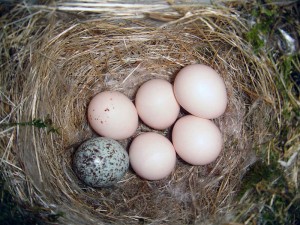Honey, I Fostered the Kids!
Brood parasitic birds lay their eggs in the nests of others, belonging either to another individual of the parasite’s species (intraspecific behaviour) or to other species of birds (interspecific). At least 85 species of birds are reportedly interspecific brood parasites (Robert & Robinson, 1985) with cuckoos and cowbirds amongst the most common (Davies, 2000), coining the popular metaphor “cuckoo in the nest”.
Benefits to parasitic avian species such as the Common Cuckoo (Cuculus canorus) include better allocation of resources towards mating and reproduction rather than building nests, incubating eggs and feeding their young. For the hosts however, reproductive success becomes adversely reduced due to abandonment of parasitized broods and competition from larger competitive parasitic hatchlings, even evicting the host eggs and killing their young (Davies, 2000). Such costs exert reciprocal natural selection on hosts and parasites, resulting in the co-evolution of several adaptations and counter-adaptations.
Egg mimicry
Defences by the host begin with the recognition and removal of parasitic eggs based largely on differences in colour, size, shape and blemishes in various combinations to elicit egg rejection. Egg recognition therefore exerts selective pressure on the parasites to lay eggs that mimic in appearance those of their host. The extent of egg mimicry and host specialization varies in parasitic birds. Many cuckoos mimic a specific subset of their host species. Cowbirds, by contrast do not lay highly mimetic eggs, instead parasitizing a wide range of hosts rather than specializing on a particular species (Croston & Hauber, 2010).
Hatchling impersonation
Recognition and rejection of parasitic hatchlings provide an alternative defence strategy for host species, in turn resulting in parasites co-evolving to impersonate its mouth-opening action and begging call. Host rejection of parasitic hatching has been demonstrated by the Superb Fairywren (Malurus cyaneus) while the evolution of begging call impersonation may have selected for in its parasite, the Horsfield’s Bronze Cuckoo (Chrysococcyx basalis). Hatchling discrimination by hosts is however relatively rare as it can only evolve when egg discrimination has failed (Croston & Hauber, 2010).
Identity unveiled
If left unexposed to conspecifics during growth, how then do parasitic hatchlings identify members of their own to mate? Instead of relying solely on cues learned from foster parents and nest-mates, brood parasites have mechanisms employed for species recognition to avoid mistakenly courting heterospecifics. The Brown-headed Cowbird (Molothrus ater) for instance relies on a codeword-like vocal trigger that unlocks learning of species-specific cues at its first encounter with a conspecific (Croston & Hauber, 2010).
Citations
Croston, R. & M. E. Hauber, 2010. The ecology of avian brood parasitism. Nature Education Knowledge, 1(9): 3.
Davies, N. B., 2000. Cuckoos, Cowbirds and other Cheats. Academic Press, London. 312pp.
Robert, M. M. & S. K. Robinson, 1985. Population dynamics of avian brood parasitism. The American Naturalist, 126(4): 475-494.
“Common Cuckoo,” by Chris Romeiks. Wikimedia Commons, 12 August 2011. URL: http://en.wikipedia.org/wiki/File:Cuculus_canorus_vogelartinfo_chris_romeiks_CHR0791_cropped.jpg (accessed on 10 April 2013)
“Cuckoo eggs mimicking Reed Warbler eggs,” by Chiswick Chap. Wikimedia Commons, 27 March 2012. URL: http://en.wikipedia.org/wiki/File:Cuckoo_Eggs_Mimicking_Reed_Warbler_Eggs.jpg (accessed on 10 April 2013)
“Eastern Phoebe nest with one Brown-headed Cowbird egg,” by Galawebdesign. Wikimedia Commons, June 2007. URL: http://en.wikipedia.org/wiki/File:Eastern_Phoebe-nest-Brown-headed-Cowbird-egg.jpg (accessed on 10 April 2013)


